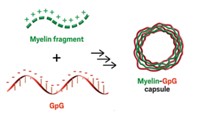Advertisement
Grab your lab coat. Let's get started
Welcome!
Welcome!
Create an account below to get 6 C&EN articles per month, receive newsletters and more - all free.
It seems this is your first time logging in online. Please enter the following information to continue.
As an ACS member you automatically get access to this site. All we need is few more details to create your reading experience.
Not you? Sign in with a different account.
Not you? Sign in with a different account.
ERROR 1
ERROR 1
ERROR 2
ERROR 2
ERROR 2
ERROR 2
ERROR 2
Password and Confirm password must match.
If you have an ACS member number, please enter it here so we can link this account to your membership. (optional)
ERROR 2
ACS values your privacy. By submitting your information, you are gaining access to C&EN and subscribing to our weekly newsletter. We use the information you provide to make your reading experience better, and we will never sell your data to third party members.
Materials
Nanoparticles Help To Stem Internal Bleeding
ACS Meeting News: Peptide anchors make polymeric particles bind blood cells together
by Bethany Halford
August 27, 2012
| A version of this story appeared in
Volume 90, Issue 35
Nanoscale polymeric particles could one day offer a lifesaving treatment for internal bleeding. Currently, emergency medical responders have few options for treating internal bleeding in the field. Now, Erin Lavik and coworkers at Case Western Reserve University have developed artificial synthetic platelets that emergency responders could administer at the scene of an accident. The particles are roughly 300 nm in diameter with a core made of poly(lactic-co-glycolic acid)—the same stuff that goes into dissolvable sutures. A covalently attached polyethylene glycol corona keeps the particles from clumping together and helps them evade the body’s immune system. Finally, a short peptide containing arginine, glycine, and aspartic acid, better known as the RGD peptide, decorates the surface. Platelets activated for clot formation have a receptor for this peptide, so the nanoparticles glom onto the platelets and help them clump together with blood cells. Lavik’s team has had success using the particles to stop internal bleeding, with no adverse effects, in small animals. Next, they hope to scale the technology up to larger animals.





Join the conversation
Contact the reporter
Submit a Letter to the Editor for publication
Engage with us on Twitter